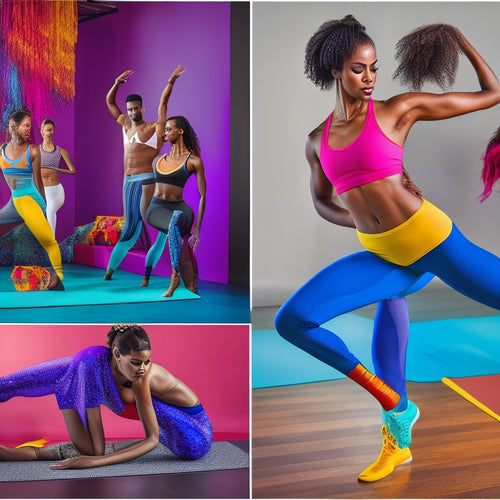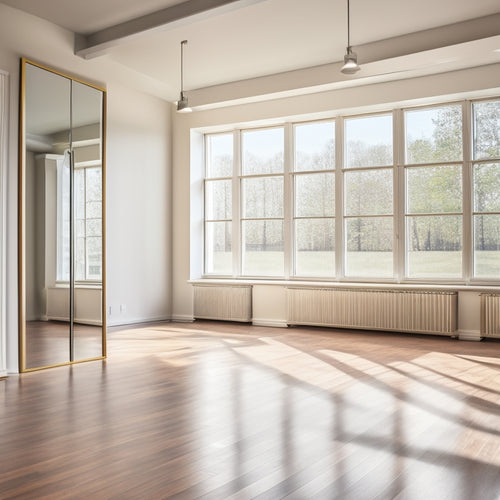
7 Essential Rhythms to Elevate Your Middle Eastern Moves
Share
As you step into the enchanting world of Middle Eastern dance, you're about to reveal a treasure trove of rhythmic possibilities. From sultry, seductive moves to dynamic, energetic beats, mastering the right rhythms can transform your dance experience. You're about to discover the 7 essential rhythms that will take your Middle Eastern moves to the next level. But which ones will resonate with you the most? Will you find yourself lost in the mesmerizing pulse of the Malfuf rhythm or energized by the dynamic Maqsum beat? Let's explore these rhythms together and uncover the secrets to elevating your dance style.
Key Takeaways
• Mastering essential rhythms like Malfuf, Maqsum, Saidi, Chiftetelli, and Karshilama elevates your Middle Eastern dance moves.
• Understanding the cultural significance and history of each rhythm enhances your performance and expression.
• Practicing rhythms like Maqsoum and Samai helps develop musicality, timing, and sensual expression.
• Embracing the unique characteristics of each rhythm, such as the hypnotic pulse of Malfuf or the playful energy of Karshilama, adds depth to your dance.
• Trusting your rhythmic intuition and surrendering to the music allows for freedom of expression and a more captivating performance.
Malfuf Rhythm for Sensual Moves
As you surrender to the hypnotic pulse of the Malfuf rhythm, your body begins to weave a sensual tapestry of movement, each step and gesture a tribute to the seductive power of Middle Eastern dance. This rhythm is designed to awaken your inner seductress, inviting you to embrace your Sensual Expression and let go of inhibitions.
As you sway to the Malfuf's gentle cadence, you'll become more attuned to your Body Awareness, allowing your movements to flow with effortless grace.
The Malfuf rhythm is a masterclass in subtlety, encouraging you to focus on the nuances of your movement and the sensations in your body. It's an invitation to slow down, breathe deeply, and let your body speak its own language.
As you surrender to the rhythm, you'll find yourself lost in the sensuality of the moment, your body moving with an organic, instinctual grace that's both enthralling and empowering. By embracing the Malfuf rhythm, you'll discover a deeper connection with your body and tap into the intoxicating power of Sensual Expression.
Maqsum Beat for Dynamic Energy
You're ready to spark your inner fire and ignite a dynamic energy that commands attention, and the Maqsum beat is the perfect catalyst, pulsating with an infectious vitality that awakens your senses and sets your body ablaze with movement.
As you surrender to the Maqsum rhythm, you'll access a world of expressive possibilities. Here are some essential tips to elevate your dance:
-
Embrace Maqsum variations: Experiment with different tempo and intensity to match your mood and style.
-
Listen to the music: Pay attention to the melody and let it guide your movements, creating a harmonious dialogue between your body and the rhythm.
-
Play with dynamics: Contrast soft and loud, fast and slow, to create a captivating visual narrative.
- Add musicality tips: Incorporate subtle pauses, accents, and gestures to add texture and depth to your dance, making it a true masterpiece.
Saidi Rhythm for Folk Flair
As you explore the Saidi Rhythm, you'll uncover the rich folk dance roots that give this rhythm its distinctive charm.
You'll discover the subtle regional style nuances that set it apart from other Middle Eastern rhythms.
With dynamic arm waves and fluid movements, you'll be ready to embody the folk flair of the Saidi Rhythm.
Folk Dance Roots
With every step, you embody the rustic charm of Egypt's countryside as the Saidi rhythm transports you to a world of earthy elegance. As you move to the rhythm, you're not just dancing - you're honoring the rich cultural heritage of the region.
The Saidi rhythm is deeply rooted in folk dance traditions, and embracing its folk roots can elevate your dance to new heights.
Here are a few ways to tap into the folk dance roots of the Saidi rhythm:
-
Embrace Traditional Costumes: Don traditional Egyptian clothing, such as a galabeya or a long, flowing skirt, to connect with the cultural heritage of the dance.
-
Learn Regional Folk Steps: Study traditional folk dances from the region, such as the Egyptian cane dance, to add authenticity to your movements.
-
Incorporate Folk Instruments: Use traditional instruments like the oud or qraqeb to create a more immersive experience.
- Immerse Yourself in Folk Culture: Attend cultural events, watch traditional dance performances, and listen to folk music to deepen your understanding of the Saidi rhythm's roots.
Regional Style Nuances
In the Saidi rhythm, regional nuances reveal themselves like a richly embroidered tapestry, each stitch unveiling the distinct character of Egypt's various regions, from the languid, sensual movements of Upper Egypt to the lively, upbeat energy of the Nile Delta.
As you explore this rhythm, you'll discover that each region brings its unique flavor to the dance. You'll find that the Saidi style is often characterized by strong, grounded movements, reminiscent of the earthy, rustic vibe of the countryside.
To add authenticity to your dance, incorporate subtle Turkish subtleties, such as the dramatic arm waves and regal posture often seen in Turkish Oriental dance. Meanwhile, the Persian flair of intricate footwork and delicate hand movements will add a touch of elegance to your performance.
As you master the Saidi rhythm, you'll find that these regional nuances will naturally begin to surface in your dance, giving you a distinct voice and style that sets you apart. By embracing these regional differences, you'll access a deeper level of expression and connection to the music, taking your Middle Eastern dance to new heights.
Dynamic Arm Waves
You'll evoke the rustic charm of the Egyptian countryside by mastering dynamic arm waves, a hallmark of the Saidi rhythm that adds a mesmerizing folk flair to your Middle Eastern dance. This signature movement is all about fluid extensions and angular contrasts, creating a captivating visual feast.
To perfect your dynamic arm waves, focus on the following key elements:
-
Relaxed Shoulders: Release tension in your shoulders, allowing your arms to move freely and fluidly.
-
Soft Elbows: Keep your elbows slightly bent, enabling your arms to wave and undulate with grace.
-
Wrist Circles: Rotate your wrists in small, delicate circles, adding a touch of whimsy to your movements.
- Arm Undulations: Allow your arms to wave and curve, creating a sinuous, snake-like motion that's both sensual and mesmerizing.
Chiftetelli Pulse for Whirling Dervishes
As you surrender to the hypnotic beat of the Chiftetelli rhythm, your body begins to sway, echoing the mesmerizing whirl of the Sufi dervishes. This ancient rhythm has been a cornerstone of Middle Eastern dance for centuries, evoking the mystique of the whirling dervishes. As you move to the Chiftetelli pulse, you're tapping into a rich history that dates back to the 13th century. The Sufi philosophy of spiritual devotion and self-discipline is deeply embedded in the rhythmic patterns, guiding your movements towards a state of trance-like ecstasy.
As you twirl and sway, you're not just dancing – you're embodying the spiritual quest of the whirling dervishes. The Chiftetelli rhythm becomes a gateway to a deeper connection with your body and the universe, allowing you to transcend the mundane and tap into the divine. With each spin, you're weaving a tale of devotion, surrender, and spiritual awakening.
Karshilama Rhythm for Playful Vibes
With the Karshilama rhythm, a lively, flirtatious energy takes hold, inviting you to surrender to playful, carefree movements that evoke the whimsy of a Middle Eastern bazaar. As you let the rhythm guide you, your body becomes a vessel for the carefree spirit of the Karshilama.
Here are some tips to help you master this playful rhythm:
-
Embrace your inner child: Let go of self-consciousness and tap into your playful side. Remember, it's all about having fun!
-
Focus on body awareness: Pay attention to your posture, alignment, and movement quality. This will help you stay grounded and connected to your body.
-
Play with dynamics: Experiment with varying levels of energy, from soft and subtle to bold and playful. This will add depth and musicality to your movements.
- Listen to the music: Allow the rhythm to guide your movements, and don't be afraid to improvise. This is where the magic happens!
Samai Rhythm for Elegant Flow
In the Samai rhythm, your body becomes an instrument of elegance, weaving intricate patterns and subtle nuances that evoke the refined sophistication of a Middle Eastern palace. As you surrender to this rhythmic flow, your movements take on a life of their own, like a delicate dance of silk and moonlight.
To master the Samai, focus on fluid shifts and subtle weight changes, allowing your body to undulate like a serpent. Remember, musicality tips are key: listen to the rhythm, and let it guide your movements.
The Samai's cultural significance lies in its ability to evoke the majesty of ancient Middle Eastern courts, where elegance and refinement reigned supreme. As you embody this rhythm, you'll exude an air of sophistication and poise, transporting yourself and your audience to a world of opulence and beauty.
Maqsoum Rhythm for Hypnotic Groove
As you explore the Maqsoum rhythm, you'll discover its hypnotic power to captivate your audience.
To master this rhythm, you'll need to grasp its basics, understand its roots in folk dance, and practice its timing until it becomes second nature.
Maqsoum Basics Explained
You explore further into the hypnotic groove of Maqsoum, a rhythm that wraps around your hips like a serpent's embrace, drawing you deeper into the mesmerizing world of Middle Eastern dance. As you surrender to its pulsing beat, you'll discover the rich history and cultural significance of Maqsoum, a rhythm with roots in ancient Egypt and Turkey.
Here are the essential basics to get you started:
-
Maqsoum history: This rhythm has its roots in ancient Egyptian and Turkish music, with influences from Arabic and African traditions.
-
Cultural significance: Maqsoum is deeply ingrained in Middle Eastern culture, often performed at weddings, celebrations, and spiritual gatherings.
-
Rhythmic pattern: Maqsoum is characterized by a slow, sensual 8-count rhythm, often accompanied by the qraqeb (metal finger cymbals) or riq (tambourine).
- Emotional connection: As you dance to Maqsoum, focus on connecting with the rhythm's hypnotic energy, allowing yourself to surrender to its sensual, mesmerizing flow.
As you explore more deeply into the world of Maqsoum, you'll discover a rich tapestry of cultural significance, historical roots, and sensual expression.
Maqsoum in Folk Dance
With every step, Maqsoum's mesmerizing rhythm weaves a sensual spell, drawing you into the rich tapestry of folk dance traditions that crisscross the Middle East. As you surrender to its enchanting pulse, you'll find yourself transported to the vibrant souks and ancient bazaars of the region. Maqsoum's cultural significance lies in its ability to evoke the rich cultural heritage of the Middle East, where music and dance are intricately intertwined.
In the historical context of folk dance, Maqsoum's rhythmic patterns are deeply rooted in the traditions of the Arab world. You'll find echoes of Maqsoum in the whirling dervishes of Sufi mysticism, the mesmerizing zeffa processions of Egyptian weddings, and the lively debke dances of Lebanese and Syrian celebrations.
As you master the hypnotic rhythms of Maqsoum, you'll discover the secrets of the Middle East's most enchanting folk dances, and surrender to the intoxicating beauty of this timeless cultural heritage.
Mastering Maqsoum Timing
To fully explore the enchanting essence of Maqsoum, focus on internalizing its rhythmic patterns, allowing the hypnotic pulse to guide your movements and awaken the seductive allure of Middle Eastern folk dance.
As you dig deeper into the world of Maqsoum, you'll discover a rich history that spans centuries, with roots tracing back to ancient Middle Eastern civilizations.
To master Maqsoum timing, remember these essential tips:
-
Listen to your body: Trust your rhythmic intuition to guide your movements, allowing your body to respond naturally to the hypnotic pulse.
-
Practice with intention: Focus on the subtle nuances of Maqsoum's rhythmic patterns, and practice with intention to internalize the rhythm.
-
Feel the pulse: Allow the hypnotic pulse of Maqsoum to guide your movements, surrendering to its seductive allure.
- Let go of self-consciousness: Embrace the freedom of expression, letting your body respond naturally to the rhythm, unencumbered by self-doubt or fear.
Frequently Asked Questions
Can I Practice Middle Eastern Rhythms With Any Type of Music?
As you set off on a sonic journey, you'll find that Middle Eastern rhythms can harmonize with diverse genres, from global playlists to cultural fusion sounds, allowing you to weave a rich tapestry of sound that's uniquely yours.
Do I Need to Be a Professional Dancer to Learn These Rhythms?
'You don't need to be a pro to learn these rhythms; prior dance experience isn't necessary. It's your personal motivation that matters - so awaken your inner dancer and let the rhythms guide you.'
Can I Mix and Match Different Rhythms in a Single Dance Routine?
"Don't worry, you won't get lost in rhythm chaos! You can absolutely mix and match different rhythms in a single dance routine, creating a sultry Rhythm Fusion that's uniquely yours through Beat Blending - it's all about feeling the flow, darling!"
How Do I Incorporate Arm and Hand Movements With the Rhythms?
As you weave together rhythms, focus on Fluid Framing, using your arms to frame your body, and Sensual Undulations, allowing your hands to flow like silk, creating a mesmerizing dance that's both enchanting and safe.
Are There Specific Costumes or Attire for Middle Eastern Dance Styles?
You won't be fooled by clichés, but yes, you'll want to adorn yourself in flowing fabrics, like chiffon or silk, and explore Veil Options to elevate your Middle Eastern dance style, darling!
Related Posts
-

What Contemporary Dancewear Essentials Do Dancers Need
As a contemporary dancer, you need essentials that enhance your flexibility and creativity. Opt for high-waisted legg...
-

Tips and Tricks for Collapsible Ballet Bar Installation
To install your collapsible ballet bar, start by gathering essential tools like a drill, level, and measuring tape. M...
-

Instant Download Card for Dance Recital Performances
Instant download cards are a convenient way to commemorate dance recital performances, providing a seamless solution ...


